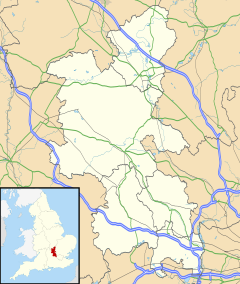Marlow, Buckinghamshire
| Marlow | |
|---|---|
 Overlooking the River Thames and Marlow |
|
| Marlow shown within Buckinghamshire | |
| Population | 14,004 (2011 Census) 14,325 (2011 Census) |
| OS grid reference | SU855865 |
| Civil parish |
|
| District | |
| Shire county | |
| Region | |
| Country | England |
| Sovereign state | United Kingdom |
| Post town | MARLOW |
| Postcode district | SL7 |
| Dialling code | 01628 |
| Police | Thames Valley |
| Fire | Buckinghamshire |
| Ambulance | South Central |
| EU Parliament | South East England |
| UK Parliament | |
Marlow (historically Great Marlow or Chipping Marlow) is a town and civil parish within Wycombe district in south Buckinghamshire, England. It is located on the River Thames, 4 miles (6.5 km) south-southwest of High Wycombe, 5 miles (8 km) west-northwest of Maidenhead and 33 miles (53 km) west of central London.
The name is recorded in 1015 as Mere lafan, meaning "Land left after the draining of a pond" in Old English.
From Norman times the manor, parish, and later borough were formally known as Great Marlow, distinguishing them from Little Marlow. The ancient parish was large, including rural areas north and west of the town. In 1896 the civil parish of Great Marlow, created in the 19th century from the ancient parish, was divided into Great Marlow Urban District (the town) and Great Marlow civil parish (the rural areas). In 1897 the urban district was renamed Marlow Urban District, and the town has been known simply as Marlow.
Marlow is recorded in the Domesday Book as Merlaue.
Magna Britannia includes the following entry for Marlow: "The manor of Marlow, which had belonged to the Earls of Mercia, was given by William the Conqueror, to his Queen Matilda. Henry the First, bestowed it on his natural son, Robert de Melhent, afterwards Earl of Gloucester, from whom it passed, with that title, to the Clares and Despencers, and from the latter, by female heirs, to the Beauchamps and Nevilles, Earls of Warwick. It continued in the crown from the time of Richard III's marriage with Anne Neville, until Queen Mary granted it to William Lord Paget, in whose family it continued more than a century; after which, it passed, by purchase, to Sir Humphrey Winch, in 1670; to Lord Falkland in 1686; to Sir James Etheridge in 1690; to Sir John Guise in 1718; and to Sir William Clayton in 1736. It is now the property of Sir William Clayton bart. a descendant of the last purchaser".
...
Wikipedia

